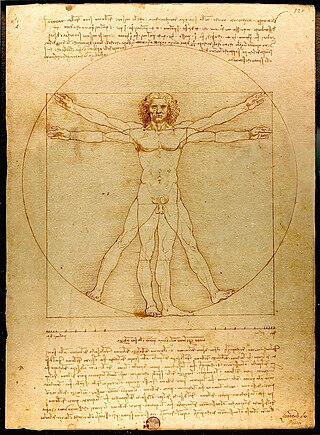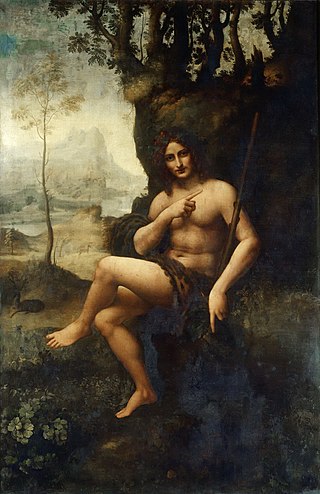
Leonardo di ser Piero da Vinci was an Italian polymath of the High Renaissance who was active as a painter, draughtsman, engineer, scientist, theorist, sculptor, and architect. While his fame initially rested on his achievements as a painter, he has also become known for his notebooks, in which he made drawings and notes on a variety of subjects, including anatomy, astronomy, botany, cartography, painting, and palaeontology. Leonardo is widely regarded to have been a genius who epitomised the Renaissance humanist ideal, and his collective works comprise a contribution to later generations of artists matched only by that of his younger contemporary Michelangelo.

Andrea del Verrocchio was an Italian sculptor, painter and goldsmith who was a master of an important workshop in Florence.

An equestrian statue is a statue of a rider mounted on a horse, from the Latin eques, meaning 'knight', deriving from equus, meaning 'horse'. A statue of a riderless horse is strictly an equine statue. A full-sized equestrian statue is a difficult and expensive object for any culture to produce, and figures have typically been portraits of rulers or, in the Renaissance and more recently, military commanders.

The Vitruvian Man is a drawing by the Italian Renaissance artist and scientist Leonardo da Vinci, dated to c. 1490. Inspired by the writings of the ancient Roman architect Vitruvius, the drawing depicts a nude man in two superimposed positions with his arms and legs apart and inscribed in both a circle and square. It was described by the art historian Carmen C. Bambach as "justly ranked among the all-time iconic images of Western civilization". Although not the only known drawing of a man inspired by the writings of Vitruvius, the work is a unique synthesis of artistic and scientific ideals and often considered an archetypal representation of the High Renaissance.

Francesco Melzi, or Francesco de Melzi (1491–1567), was an Italian painter born into a family of the Milanese nobility in Lombardy. He became a pupil of Leonardo da Vinci and remained as his closest friend and professional assistant throughout his career. After da Vinci’s death, Melzi became the literary executor of all da Vinci's papers and compiled them into a manuscript known as the Codex Urbinas. This compilation later served as the basis for the Trattato della Pittura, which was published posthumously by others based on Melzi’s organization of da Vinci’s notes.

The Portrait of a Musician is an unfinished painting by the Italian Renaissance artist Leonardo da Vinci, dated to c. 1483–1487. Produced while Leonardo was in Milan, the work is painted in oils, and perhaps tempera, on a small panel of walnut wood. It is his only known male portrait painting, and the identity of its sitter has been closely debated among scholars.

Bacchus, originally Saint John the Baptist, is a painting in the Musée du Louvre, Paris, France, by the Italian Renaissance artist Leonardo da Vinci and Francesco Melzi, while in Leonardo's workshop. Sydney J. Freedberg assigns the drawing to Leonardo's second Milan period. Among the Lombard painters who have been suggested as possible authors are Cesare da Sesto, Marco d'Oggiono, Francesco Melzi, and Cesare Bernazzano. The painting shows a male figure with garlanded head and leopard skin, seated in an idyllic landscape. He points with his right hand off to his left, and with his left hand grasps his thyrsus and also points down to earth.

The Codex Atlanticus is a 12-volume, bound set of drawings and writings by Leonardo da Vinci, the largest single set. Its name indicates the large paper used to preserve original Leonardo notebook pages, which was used for atlases. It comprises 1,119 leaves dating from 1478 to 1519, the contents covering a great variety of subjects, from flight to weaponry to musical instruments and from mathematics to botany. This codex was gathered in the late 16th century by the sculptor Pompeo Leoni, who dismembered some of Leonardo's notebooks in its formation. It is now in the Biblioteca Ambrosiana in Milan.

Leonardo's Horse is a project for a bronze sculpture that was commissioned from Leonardo da Vinci in 1482 by the Duke of Milan Ludovico il Moro, but never completed. It was intended to be the largest equestrian statue in the world, a monument to the duke's father Francesco Sforza. Leonardo did extensive preparatory work for it but produced only a large clay model, which was later destroyed.

Portrait of a Man in Red Chalk is a drawing currently in the collection of the Royal Library of Turin. It is widely, though not universally, accepted as a self-portrait of the Renaissance artist Leonardo da Vinci. It is thought that da Vinci drew this self-portrait at about the age of 60. The portrait has been extensively reproduced and has become an iconic representation of him as a polymath or "Renaissance man". Despite this, some historians and scholars disagree as to the true identity of the sitter.

The Lucan portrait of Leonardo da Vinci is a late 15th- or early 16th-century portrait of a man. The picture was discovered in 2008 in a cupboard of a private house in Italy.

Gian Giacomo Caprotti da Oreno, better known as Salaì was an Italian artist and pupil of Leonardo da Vinci from 1490 to 1518. Salaì entered Leonardo's household at the age of ten. He created paintings under the name of Andrea Salaì. He was described as one of Leonardo's students and lifelong companion and servant and was the model for Leonardo's St. John the Baptist, Bacchus and Angelo incarnato.

Bernardino de 'Conti was an Italian Renaissance painter, born in 1465 in Castelseprio and died around 1525.

La Scapigliata is an unfinished painting generally attributed to the Italian High Renaissance artist Leonardo da Vinci, and dated c. 1506–1508. Painted in oil, umber, and white lead pigments on a small poplar wood panel, its attribution remains controversial, with several experts attributing the work to a pupil of Leonardo. The painting has been admired for its captivating beauty, mysterious demeanor, and mastery of sfumato.
Horse and Rider may refer to:

The Rearing Horse and Mounted Warrior or Budapest horse is a bronze sculpture attributed to Leonardo da Vinci. Depicting Francis I of France on a destrier horse, it is estimated to have been cast from a clay or wax model in the first half of the 16th century. The sculpture is in the permanent exhibit of the Budapest Museum of Fine Arts.

Flora is a painting by Francesco Melzi, completed c. 1520. It depicts the Roman mythological figure Flora, the goddess of springtime and flowers, a popular subject among Renaissance artists. The painting was in the collection of Maria de’ Medici in 1649 and has been in the collection of Hermitage Museum, in St. Petersburg, since 1850.

Vertumnus and Pomona is a painting by Francesco Melzi dated to c. 1518–1522. It depicts the Roman god of the seasons Vertumnus in the guise of an old woman attempting to woo the lady Pomona. It is in the collection of the Gemäldegalerie of the Berlin State Museums.

The Head of the Virgin in Three-Quarter View Facing Right is a drawing on paper in pierre noir pencil and red chalk, attributed to the Florentine painter Leonardo da Vinci and kept at the Metropolitan Museum of Art in New York.




















